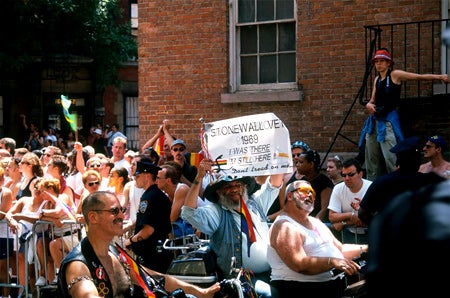Thoughts on the Pride March, past, present, and future

Larry Qualls | Heritage of Pride March, 30th Anniversary of the Stonewall Riots | 27 June, 1999 | New York City, NY | Image and original data provided by Larry Qualls
June is Pride Month, and the month in which New York City’s famous annual Pride March parades down Fifth Avenue towards Christopher Street in front of the Stonewall Inn, birthplace of the historic Stonewall Riots of 1969. As I meander around Greenwich Village days before the event, I pull out my phone and begin taking unsteady shots of the infamous bar’s sign. Under the rather modest pride flags that border the doorframe (and a printout taped to the window that quotes Obama’s much-feted reference to the riots in his second inaugural speech), I consider how perhaps no one would have suspected this somewhat sleepy locale (granted, it was a Tuesday) would have engendered what would become the national push for pride and equality in LGBTQA communities everywhere.
I might have been better off perusing the Magnum Photos collection in the Artstor Digital Library. In particular, the 1,000+ images by Paul Fusco masterfully chronicle moments from New York City’s vibrant Pride past. The photographs taken during 1994’s “Stonewall 25 March”—which boasted the attendance of 1.1 million people and began at the UN headquarters and moved all the way to Central Park—illustrate the wildly variant faces of this cultural movement. Sure, some images feature the ostentatious, feathered costumery that pride parades can invoke; but there are others that capture the vibrant spirit of community, change, and remembrance that such demonstrations achieve. Fusco has written that he ultimately desires from his photographs that “… the reality of those lives [become] emotionally and intellectually understandable to others.” That aim is underscored in his Pride series due to the necessity of such representation for queer communities that have been historically marginalized and sequestered.

Larry Qualls | The 29th Annual Gay Pride March | 28 June, 1998 | New York City, NY | Image and original data provided by Larry Qualls
Larry Qualls, New York City’s famed art scene documentarian, is also a key contributor of Pride photography in the Artstor Digital Library. His images from Pride Parades from the last two decades capture the triumphant diversity that such celebrations inspire. From Riot Grrl dyke marches to Quaker Pride floats, his bejeweled subjects supply no dearth of fervor for equality. The moments Qualls captures are spontaneously raw, organic. His subjects are unposed and sweaty; their faces drip make-up as they are captured mid-shout, mid-fist-pump on 42nd Street. This is all part of Pride: the beautiful gowns, confettied sidewalks, and all that dancing in the streets. Qualls’s lens doesn’t miss a moment. He’s there for the expected drag performer du jour, and for the more surprising moments, such as the appearance of the NYC Gay Officers marching group. By capturing the organic, buoyant grime of a pointedly New Yorker version of gay rights, Qualls provides a necessary counterpoint to the composed dignity of Fusco’s version of Pride.
It is impossible not to feel a sense of urgency in the fight for equal rights for same-sex couples. Tittering on the brink of concrete equality with the recent repeal of DOMA by the Supreme Court, the Pride celebrations this past weekend reiterated the excitement and potentiality of the cause. However, as we throw our streamers into the streets, we should keep in mind that New York City’s Police Commissioner recently announced that anti-gay hate crimes increased more than 70% this year. We must not forget the Greenwich Village hate murders of Mark Carson, steps from the Stonewall Inn, or the killing of lesbian Sakia Gunn in Newark, NJ. And as we look through the moving photographs of Pride members from Fusco, Qualls, and others, we must remember the plight behind the glitter and smiles. The wake of progress towers momentously, belatedly, before us. Let us hold these images near us and not forget the past of Pride.
Christina Riley
Search the Artstor Digital Library for gay pride to see dozens of images by Paul Fusco, Larry Qualls, fellow photographers such as Nikos Economopoulos, Rene Burri, Chien-Chi Chang, and more.